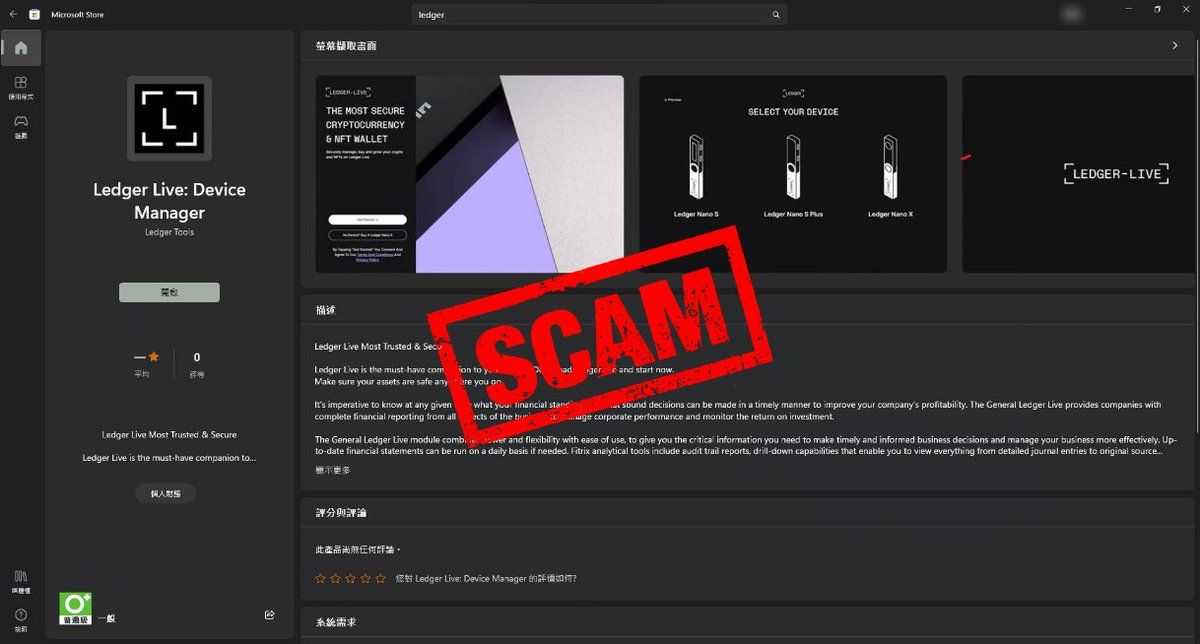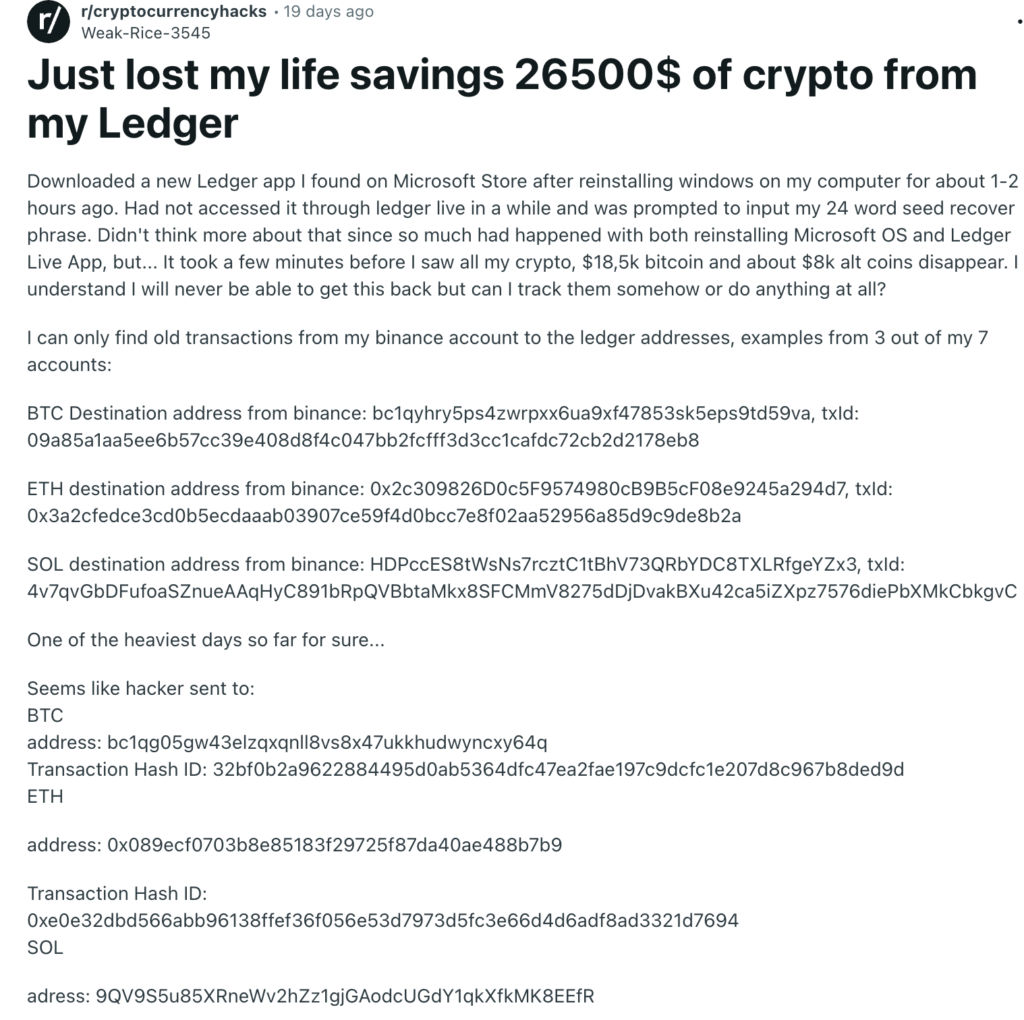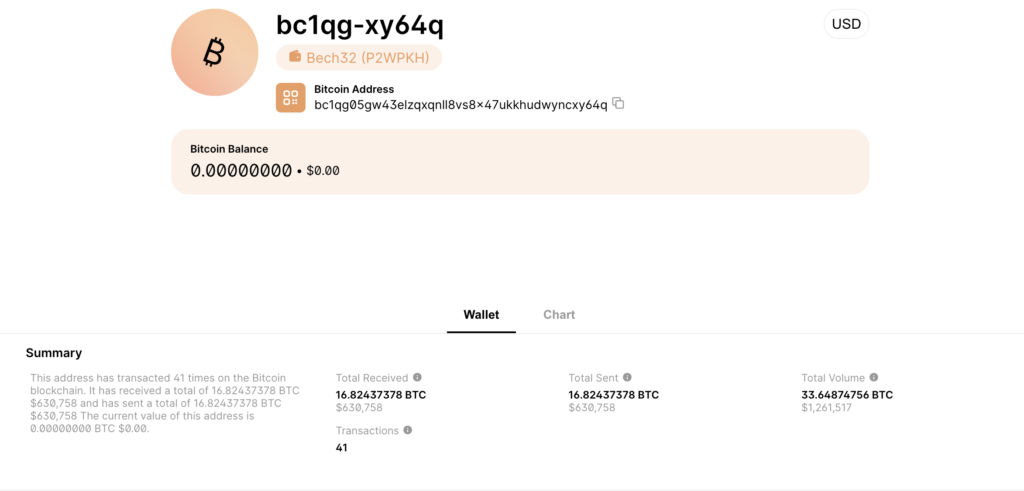Microsoft removed the app on the same day the fraud was discovered, but not before the scammer transferred more than $768,000 from victims.

The cryptocurrency community recently faced a significant security breach involving a counterfeit Ledger Live application on the Microsoft App Store. This incident, which led to the theft of over $768,000 in crypto assets, serves as a stark reminder of the vulnerabilities in digital asset security and the importance of vigilance among users.
The Scam’s Execution
- Red Flags Ignored: Despite several red flags, such as a lack of legitimate reviews (only one five-star rating) and the developer name listed as “Official Dev,” the app managed to deceive users. The description was almost entirely copied from the legitimate app in the Apple Store.
Victims’ Experiences: Multiple victims reported significant losses, with one Reddit user sharing a loss of their life savings totaling $26,500 shortly after entering their seed phrase into the fake app.

Presence in Microsoft Store: The fraudulent app, named “Ledger Live Web3,” was present in the Microsoft Store since October 19. The thefts were reported a few days later, indicating a brief but impactful window of vulnerability.

The Response and Aftermath
- Microsoft’s Action: Microsoft removed the app on the same day the fraud was discovered, but not before the scammer transferred more than $768,000 from victims.
- Investigation and Vetting Process: Microsoft is reportedly working to ensure malicious content is identified and removed quickly. However, the incident raises questions about the effectiveness of the app vetting process.
Lessons and Recommendations
- User Vigilance: This incident reinforces the need for users to be extremely cautious, especially when inputting sensitive information like recovery phrases. Authentic apps from companies like Ledger or Trezor will never ask users to enter their recovery phrases into their computers or phones.
- Authenticity Verification: Users should verify the authenticity of apps by checking official sources and being wary of any discrepancies in app descriptions, developer names, and user reviews.
The Scam Unfolds
Hackers managed to sneak a fake Ledger Live app into the Microsoft App Store, deceiving users into believing it was the legitimate application for Ledger, a renowned cryptocurrency hardware wallet manufacturer. This counterfeit app was designed to look and function like the real Ledger Live app, making it difficult for users to distinguish the fake from the genuine.
Those who were tricked into downloading the counterfeit version of the app inadvertently installed malware that could steal cryptocurrency. This malware worked by capturing the recovery phrases of users, particularly targeting those who used Ledger hardware wallets, with the aim of stealing their digital assets.
The creators of the fake app were quite deceptive, meticulously imitating the appearance and functionality of the genuine app, down to the logos and branding. They even went to the extent of fabricating a bogus Ledger device pin verification process. The striking resemblance between the authentic and the counterfeit apps posed a significant challenge for users in distinguishing the real one from the fake.
Financial Impact and Transaction Details
The consequences of this scam were significant. According to on-chain analyst ZachXBT, the attackers stole over 16.8 bitcoins, valued at approximately $588,000 in BTC, and an additional $180,000 in ETH, bringing the total loss to over $768,000. This theft not only highlights the financial risks involved but also underscores the sophistication of the methods used by cybercriminals in the crypto space.
Detailed Scam Dynamics
- Transaction Details: The first transaction to the scammer’s wallet occurred on October 24, with the wallet remaining inactive before that date. The largest transfer was $81,200 on November 4. About $115,200 has left the scammer’s wallet, leaving it with around $473,800 or 13.5 BTC.
- App Discovery and Removal: The fraudulent app was first spotted on November 5 and had been present in the Microsoft Store as early as October 19. Microsoft has since removed the app and is working to prevent similar incidents.
Financial Losses: The fake Ledger Live app, identified as “Ledger Live Web3,” led to the theft of nearly $600,000 in Bitcoin. The scammer received approximately 16.8 BTC, worth about $588,000, across 38 transactions.

ZachXBT’s Contributions and Findings
- Initial Discovery and Alert: ZachXBT was instrumental in bringing attention to the counterfeit Ledger Live app scam. He alerted the cryptocurrency community about the fake Ledger Live app on the Microsoft Store, which resulted in significant Bitcoin theft.
- Details of the Theft: According to ZachXBT, the fake app led to the theft of over 16.8 bitcoins, worth approximately $588,000. He highlighted the scale of the theft and the sophistication of the scam.
- Additional Victim and Losses: Beyond the initial Bitcoin theft, ZachXBT reported that another victim with an ETH/BSC address lost $180,000 due to the fake Ledger application. This brought the total estimated loss to over $768,000.
- Critique of App Vetting Processes: ZachXBT raised concerns about the app vetting processes of major platforms like the Microsoft App Store. He questioned how such a fraudulent app could bypass the usual security checks, suggesting that these processes might not be as diligent as required.
- Response to Community Queries: In response to community questions about how such a scam could occur, ZachXBT indicated that app companies might not be vetting apps thoroughly enough, which allows for such fraudulent activities to slip through.
- Historical Context: ZachXBT also noted that this wasn’t an isolated incident. He pointed out that similar scams had occurred before, including a fake app related to Trezor, another hardware wallet manufacturer, which appeared in the Apple App Store.
- Advocacy for Accountability: ZachXBT argued that Microsoft should be held liable for allowing the fake Ledger Live app to appear in its app store, emphasizing the need for more stringent app review processes to prevent such scams.
- Direct Communication with Victims: ZachXBT received messages from multiple victims who had lost cryptocurrency after installing the fake app, which further underscored the real-world impact of the scam.
ZachXBT’s analysis and reporting were crucial in uncovering the details of the counterfeit Ledger Live app scam. His findings not only highlighted the financial losses incurred by the victims but also raised important questions about the security measures and vetting processes of app stores. This incident, as brought to light by ZachXBT, serves as a stark reminder of the risks associated with digital asset management and the importance of vigilance in the cryptocurrency community.
The Response and Similar Previous Instances
Upon discovery, Microsoft promptly removed the fraudulent app from its store. However, the incident raised questions about the effectiveness of app vetting processes on major platforms like Microsoft, Apple, and Google. These tech giants have faced similar issues in the past, where rogue applications masquerading as legitimate software have slipped through their review processes.
March 2021 saw a devastating event for one individual who fell for a counterfeit Trezor application found in Apple’s App Store, resulting in the loss of his entire bitcoin savings. The culprits made off with 17.1 bitcoins. The victim expressed more fury toward Apple than the actual robbers in a statement to The Washington Post.
At the time, Apple said, “In the limited instances when criminals defraud our users, we take swift action against these actors as well as to prevent similar violations in the future.”
Microsoft, Apple, and Google’s app stores have inadvertently permitted numerous imposter apps masquerading as legitimate software. These applications are often crafted to phish for a user’s seed or login details with the intent to hijack their funds. Vigilance is key when verifying an app’s legitimacy; this includes scrutinizing for typos, mismatched icons or explanations, and the developer’s contact details.
Microsoft’s Role and Responsibility
- Accountability: The presence of the fake app in the Microsoft Store has raised questions about Microsoft’s responsibility in vetting applications. ZachXBT, the on-chain analyst who identified the scam, suggested that Microsoft should be held liable for allowing the fake app on its platform.
- Previous Incidents: This is not the first instance of a fake Ledger Live app appearing in Microsoft’s app store. Ledger’s support account had previously informed users about similar counterfeit apps in December and March.
User Vigilance is Key
This event underscores the critical need for users to remain vigilant when downloading and using applications related to cryptocurrency management. Users should scrutinize apps for red flags such as typos, mismatched icons, and questionable developer contact details. Additionally, it’s crucial to download apps only from verified sources, and never from third-party stores.
Ledger’s Response and Recommendations
Ledger’s support team took immediate action to alert the community about the counterfeit application. They emphasized that Ledger never asks for users’ 24-word recovery phrases and advised downloading Ledger Live only from their official website.
Ledger: ‘We Certainly Do Report It, but Only Microsoft Can Take It Down and Work on Their Side’
Ledger also recommends users verify the authenticity of their binary installation file by comparing its hash value with the one listed on their website.
Lessons Learned
This incident serves as a cautionary tale for the crypto community. It highlights the need for enhanced security measures and user education to combat the evolving tactics of cybercriminals. Users must exercise extreme caution, especially when dealing with applications that handle sensitive financial information.
Conclusion
The counterfeit Ledger Live app scam is a reminder of the ongoing battle against cyber threats in the cryptocurrency world. As the industry continues to grow, so does the sophistication of attacks. It’s imperative for both users and companies to stay ahead of these threats through vigilance, education, and robust security practices. This incident serves as a stark reminder of the persistent threats in the digital asset space and the need for continuous vigilance and education to safeguard against such sophisticated scams.

